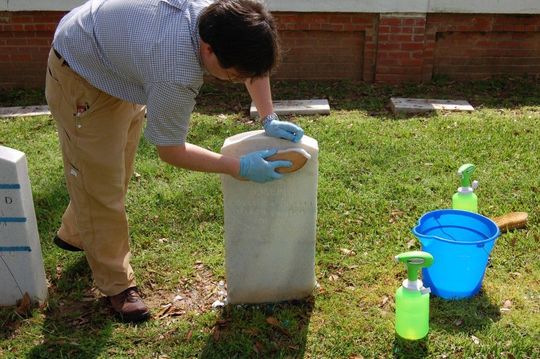Taking proper care of Government issues marble headstones
 Best Practice Recommendations for Cleaning Government-Issued Marble Headstones (2011-17)POSTED BY MARY STRIEGEL ON JULY 21, 2011 · IN CEMETERY CONSERVATION, MATERIALS CONSERVATION, PRODUCT CATALOG
Jason Church demonstrates the proper technique for cleaning a marble headstone using a biocidal cleaner, water, and a soft bristle brush.
In 2004, the Department of Veteran Affairs National Cemetery Administration turned to NCPTT when it wanted advice on chemical cleaners for their marble headstones. This began and partnership and extensive research on the subject of commercially available cleaners for removing biological growth and general soiling from marble headstones.
This week, NCPTT's Mary Striegel reported the results of the six-year VA-funded study to Steve Muro, the VA Under Secretary for Memorial Affairs, and a variety of National Cemetery Administration officials. Based on NCPTT research, the U.S. Department of Veterans Affairs will implement new policies that ban bleach-containing cleaners and encourage the use of gentle biocidal cleaners for regular maintenance of more than three million headstones nationwide. The results of the study led NCPTT to develop a document on the best practice for cleaning government-issued marble headstones, which can be downloaded here.
Download (219 KB)
Best-Practices-Final.pdf
The main recommendations include the following:
- Cleaning should be undertaken with the mildest, least-abrasive method.
- A biocidal cleaner performed the best in this study. Recommended biocidal cleaners include D/2 Biological Solution (which was tested in this study) manufactured by Sunshine Makers, Enviro Klean® BioWash®, or other cleaners that contain quaternary ammonium compounds.
- Soak the stone liberally with water before applying the cleaner with a hand or backpack sprayer or garden hose.
- Always keep the stone wet during cleaning and thoroughly rinse afterwards.
- Agitate the surface gently in a circular motion using a soft bristle brush. Clean small areas from the bottom up.
- Remember to rinse after cleaning each area and to thoroughly rinse the stone at the end to make sure that no cleaner is left behind.
The research which led to these recommendations included field and laboratory studies that cut across disciplines from chemistry and biology to materials science and conservation treatment development. There were two main goals of the study. The first goal was to find effective commercial cleaners that removed soiling and microorganisms which alter the appearance and degrade headstones. The second goal was to look at factors that led to the re-growth of microorganisms on the stone.
NCPTT researchers studied five different cleaners which can be easily applied in the field. The cleaners needed to be effective in improving the appearance of the headstone and do no harm to the marble. In the field, NCPTT evaluated cleaners on stones located at five different climates and in both sunny and shady environments. Microbiologists at Harvard's School of Engineering and Applied Sciences evaluated the microorganisms originally on the stone including bacteria, fungi, and algae. They helped to follow the re-growth on the headstones after cleaning over an eighteen-month time period. Additionally, they conducted accelerated laboratory tests using fungi to distinguish between the best field performing cleaners.
|